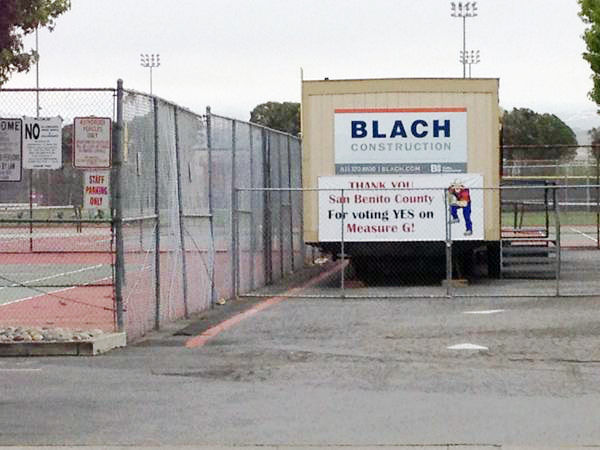It isn’t a big surprise that San Benito High School District officials are broaching the potential for a second facilities bond. That’s because the first one approved in 2014 covered about half of the district’s mega-campus “modernization” master plan that includes more than $80 million in projects that could be funded by the bond and general fund—with about $20 million of it slated for sports-related expenses.
Considering the list of projects ongoing or included in the master plan, voters should take an increasingly skeptical view of the district’s priorities for the future and prospects for a second bond.
An already cynical electorate barely approved Measure G—the $42.5 million district facilities bond—in the June 2014 election when supporters had the advantage of low turnout. It passed with 56.32 percent of the vote while needing 55 percent for approval. During the campaign, district officials rebutted concerns that much of the money would go toward sports projects, in a community with significant academic challenges, and vowed to keep athletic-related expenditures at the bottom of the priority list.
That bond priority list’s ongoing or completed projects—starting with non-athletic endeavors—include $500,000 for classroom roof replacements; $1.6 million for a Nash Road closure; $200,000 for demolition of old classrooms; $3.1 million for air-conditioning in the 300 and 400 classroom wings; $600,000 for the 300 wing classroom modernization; $17.4 million for a vocational education building; $3.6 million for communications upgrades; $8.3 million toward a wrestling/physical education building; $3 million for new tennis courts and a parking lot; and $800,000 for a gym repair.
That list does include mostly non-athletic projects, but the sports-related slate still adds up to a staggering $12.1 million in costs among $39 million-plus—that’s general fund and bond expenses—committed toward master plan projects. The waiting list for a secondary wave of projects also includes $8 million toward a pool.
San Benito High School District leaders have argued that the wrestling/P.E. center and gym renovation—making up $9.1 million of the sports total so far—are funded through the discretionary general fund.
This is an offensively misleading argument for two reasons.
For one, it’s all taxpayers’ money in the end, and using discretionary funds on athletic projects means officials are taking those dollars away from other possible expenditures such as work on classrooms or hiring more good educators.
Additionally, it was no coincidence that the district started work on the “non-bond” projects after voters approved Measure G. Is it really believable that the district would have spent all that discretionary money on a new wrestling room and gym renovations—or that the teachers’ union would have let officials get away with it—without a $42.5 million cushion? Plus, district officials are using $3 million in Measure G funds for tennis courts, which they apparently deem as more important than other projects on the bond waiting list such as A.C. in two other wings of classrooms, a science modernization and a special education modernization.
Whether it’s the classification of dollars or the allocation of bond funds toward athletic facilities, the district has betrayed the general electorate’s trust. The high school culture insists on appeasing a reckless, selfish crowd that continues to put sports dreams ahead of academic ambitions. Until the trend reverses, voters who believe that academics are the only priority for academic institutions should express it at the polls.
The Community Insight Board is an independent panel of volunteers who meet to discuss local issues. This group forms opinions based on majority consensus, but members do not always agree on every issue. Members include Jae Eade, Cesar Flores, Frankie Gallagher, Gordon Machado, Brenda Weatherly and Jim West. If you are interested in joining the panel, email moderator Kollin Kosmicki at kk*******@********ia.com.










